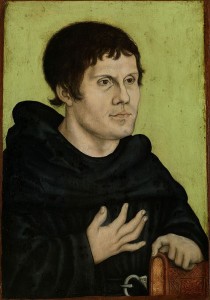The Big Tent and the Catholic Church
 (“Posthumous Portrait of Martin Luther as an Augustinian Monk,” the Workshop of Lucas Cranach the Elder, after 1546. Source: Wikimedia, Creative Commons License).
(“Posthumous Portrait of Martin Luther as an Augustinian Monk,” the Workshop of Lucas Cranach the Elder, after 1546. Source: Wikimedia, Creative Commons License).
December 26, 2016
by Chase Padusniak
A(c) as I biheeld into the eest an heigh to the sonne,
I seigh a tour on a toft trieliche ymaked,
A deep dale bynethe, a dongeon therinne,
With depe diches and derke and dredfulle of sighte.
A fair feeld ful of folk fond I ther bitwene—
Of alle manere of men, the meene and the riche,
Werchynge and wandrynge as the world asketh.
(Piers Plowman, B Text, Prologue, ll. 13-19)
These words come from the beginning of one of my favorite poems in the English language, a masterpiece deeply concerned with the manner and workings of communal and individual salvation in a fallen world filled with corrupt priests, shifty merchants, and braniac theologians disconnected from the realities of the Black Death-scarred English countryside. In case you have trouble with the Middle English, the lines might be summarized in a sentence: I saw a tower (heaven) and a dungeon (hell) and people of all types, rich and poor, but altogether wondrous, in between.
Langland means the world: Middle Earth, the place of being between hell and heaven, an image older than this poem and famously appropriated by Tolkien some 600 years later. In his England, however, virtually everyone was a Catholic, at least nominally. And so, we might not take this observation about “alle manere of men” to be just about the world but also about the Church. In sum, the Church ought to be multifarious. Who can separate the chaff from the wheat? Or, as Augustine asks of us: who can tell whose heart is truly dedicated to the City of God?
This is true of salvation, but how much more of the interpretive fecundity of our Sacred Tradition. Allow me to explain: recently a friend of mine decided to enter the Church; he is currently a Lutheran. I can’t remember if he has said it explicitly, but one thing has been clear about this conversion: he finds it liberating, comforting. In fact, he’s reminded me of something so fundamental to the Church, so unbelievably central to our way of being, that it ought to amaze us how easily we forget it: the Church is a big tent.
Banal? Sure. But true! Between the Dubia and the Culture Wars, you might be excused for forgetting this, but, it’s true: the definition of orthodoxy is a wide one. That is not to say that no boundaries exist; in fact, they exist for good reason: you can’t have meaning without delimitation. Too much delineation and you can’t save anyone, not enough and you end up Episcopalian.
http://www.patheos.com/blogs/jappersandjanglers/2016/12/big-tent-catholic-church/
